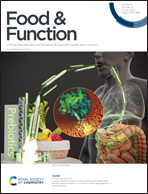Eicosapentaenoic acid is associated with the attenuation of dysfunctions of mesenchymal stem cells in the abdominal aortic aneurysm wall†
Abstract
Abdominal aortic aneurysm (AAA) is a vascular disease characterized by progressive dilation of the aorta which is reportedly associated with inflammation. Previous studies suggested that eicosapentaenoic acid (EPA) has suppressive effects on AAA development via anti-inflammatory activities. However, relationships between the anti-inflammatory effects and the cells in the AAA wall are poorly understood. In this study, we visualized the distribution of EPA-containing phosphatidylcholine (EPA-PC) in the AAA wall. EPA-PC was not ubiquitously distributed in both animal (hypoperfusion-induced AAA model) and human AAA walls, suggesting the preferential incorporation of EPA into certain cells. In the EPA-PC-high region of both animal and human AAAs, mesenchymal stem cell (MSC) marker positive areas were significantly higher than those in the EPA-PC-low region. Matrix metalloproteinase-positive MSCs were significantly lower in the AAA wall of the animal model which was administered EPA-rich fish oil. These data suggest that EPA is associated with the attenuation of MSC dysfunctions, which result in the suppression of AAA development.

- This article is part of the themed collection: Food & Function HOT Articles 2022


 Please wait while we load your content...
Please wait while we load your content...